GDP RSM Georgia Training Team, ROTO 9 PME of Belleau Wood, France
By: 1stSgt Michael D. Grant, USMC 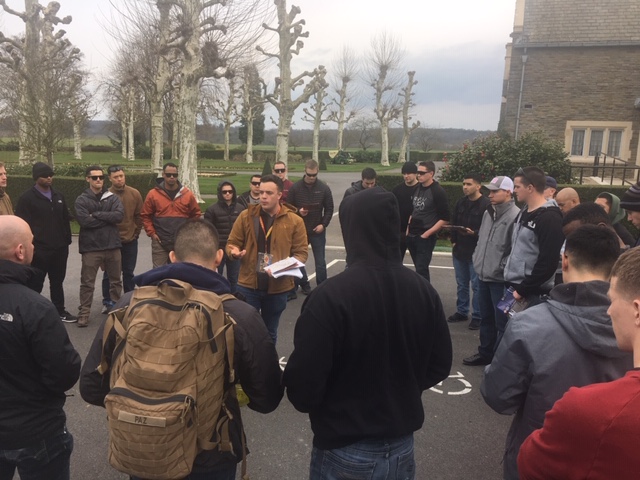 Dear MCUF: We appreciate the donation that allowed us to take 48 Marines and Sailors to Belleau Wood to conduct a battle field study. We understand that the request came to you at the last minute and yet you were still able to accommodate our request, which immensely benefited our Marines. We did have a Captain in our group who majored in history that took on the task to facilitate the tour of the battlefield. His passion for history along with his desire to someday teach was reflected throughout the entire event. Though the logistics of the movement left us exhausted, the overall experience was well worth it.
Dear MCUF: We appreciate the donation that allowed us to take 48 Marines and Sailors to Belleau Wood to conduct a battle field study. We understand that the request came to you at the last minute and yet you were still able to accommodate our request, which immensely benefited our Marines. We did have a Captain in our group who majored in history that took on the task to facilitate the tour of the battlefield. His passion for history along with his desire to someday teach was reflected throughout the entire event. Though the logistics of the movement left us exhausted, the overall experience was well worth it. 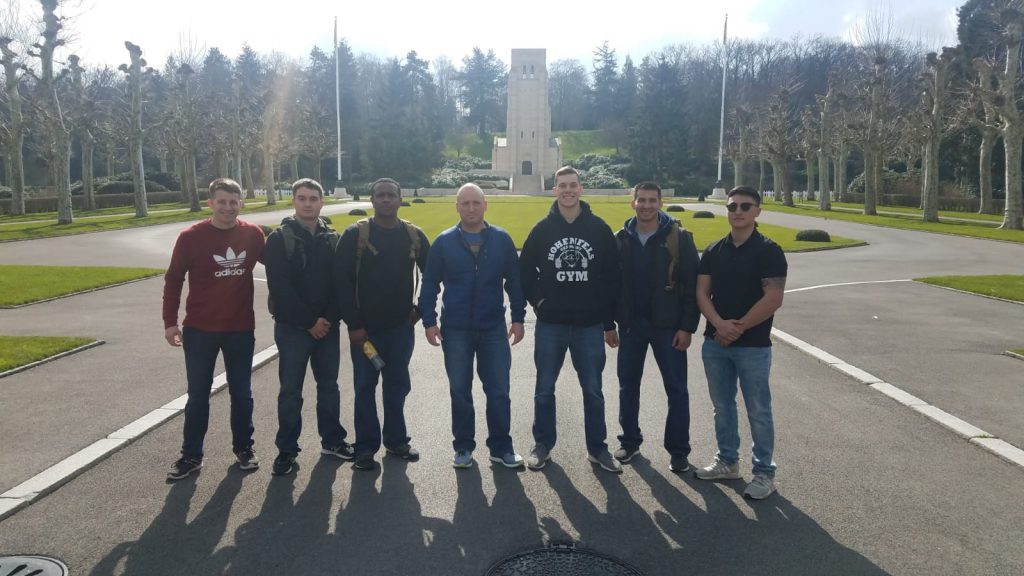 We began our trip by boarding the buses at 0100 to begin our 11-hour movement to Belleau, France. Upon arrival the curator took us into the front entrance of his office and began telling us general information about the battle. We found it sobering when he began to read the letters from the Marines that actually fought this pivotal battle. This was followed by letters from the Germans who fought against them. The Marines were ensnared by the words of one particular German soldier who referred to the Marines as being tenacious, seemingly unscathed by the death of their fellow service members and while close quarter hand to hand combat was taking place, they noticed the smell of alcohol on their breath. This German’s account of the Marine Corps Spirit of honor to our country, courage under fire and commitment to the mission as well as each other had us full of pride while recognizing the sobering results of thousands of Marines who came before us.
We began our trip by boarding the buses at 0100 to begin our 11-hour movement to Belleau, France. Upon arrival the curator took us into the front entrance of his office and began telling us general information about the battle. We found it sobering when he began to read the letters from the Marines that actually fought this pivotal battle. This was followed by letters from the Germans who fought against them. The Marines were ensnared by the words of one particular German soldier who referred to the Marines as being tenacious, seemingly unscathed by the death of their fellow service members and while close quarter hand to hand combat was taking place, they noticed the smell of alcohol on their breath. This German’s account of the Marine Corps Spirit of honor to our country, courage under fire and commitment to the mission as well as each other had us full of pride while recognizing the sobering results of thousands of Marines who came before us. 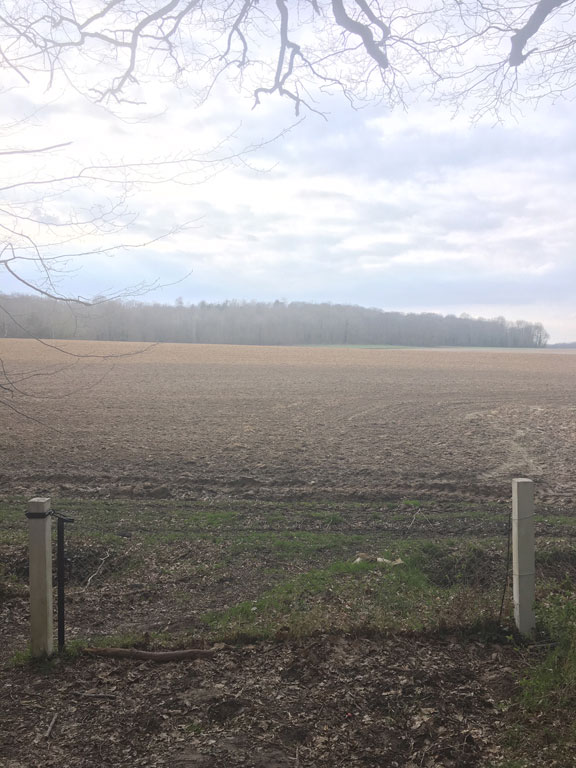
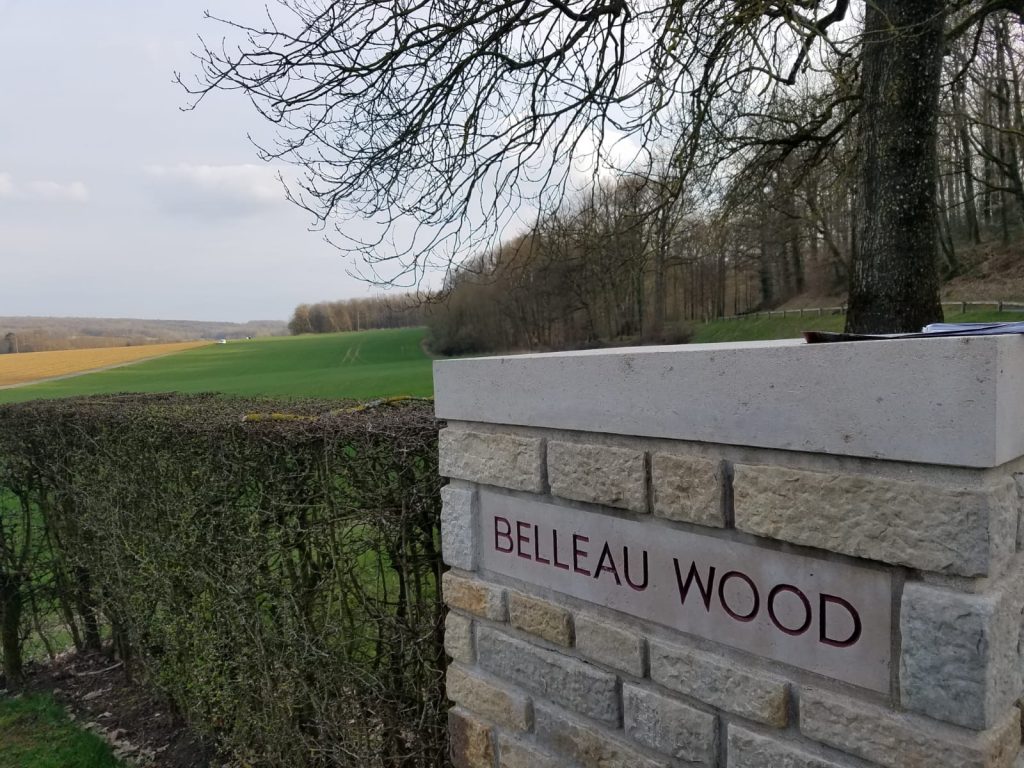 We then exited the office and proceeded to the grand entrance through the well manicured landscaping. Our heavy hearts noticed the tombstones that welcome you to this sacred ground. After a brief pause to capture this moment in time we proceeded out the front gate, through the outskirts of Belleau until we reached the Devil Dog Fountain. This fountain is owned by a local who allows visitors to come down a drink from water being pulled from a spring that has provided water to this town for centuries. Though not present during the actual Battle of Belleau Wood the water drank by those that came before us would have come from the same source. The water was cool, sweet and refreshing needing no help from modern technology to obtain this feat. After hearing the legend that drinking from this fountain could add ten years to your life, we began to fill multiple bottles! Once we all collected our share of the water we secured the gate and began marching toward the German Cemetery.
We then exited the office and proceeded to the grand entrance through the well manicured landscaping. Our heavy hearts noticed the tombstones that welcome you to this sacred ground. After a brief pause to capture this moment in time we proceeded out the front gate, through the outskirts of Belleau until we reached the Devil Dog Fountain. This fountain is owned by a local who allows visitors to come down a drink from water being pulled from a spring that has provided water to this town for centuries. Though not present during the actual Battle of Belleau Wood the water drank by those that came before us would have come from the same source. The water was cool, sweet and refreshing needing no help from modern technology to obtain this feat. After hearing the legend that drinking from this fountain could add ten years to your life, we began to fill multiple bottles! Once we all collected our share of the water we secured the gate and began marching toward the German Cemetery. 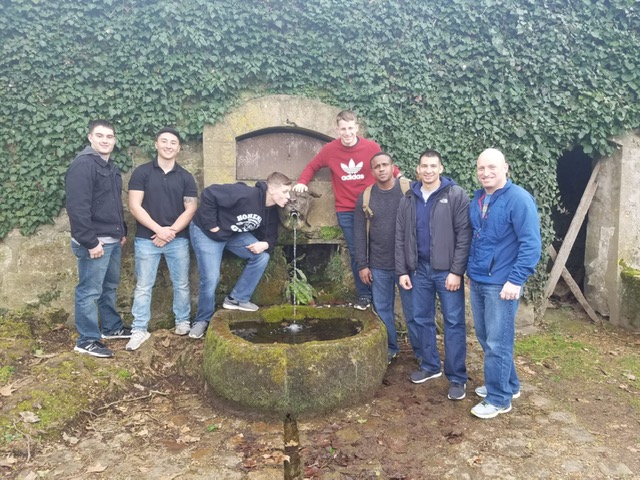 The foot movement to the German cemetery took us up and out of the sleepy town of Belleau and onto a small road leading to Bussiares. Walking along this route, flanked by vast expanses of farmland, it was hard to imagine the carnage and utter destruction that took place here just 100 years ago. After a short time of walking in a ranger file up the side of the road, we came upon a small gated cemetery with an oxidized sign on the side reading “Deutsche Kreigsgraberstatte Belleau” or, “German War Graves of Belleau.”
The foot movement to the German cemetery took us up and out of the sleepy town of Belleau and onto a small road leading to Bussiares. Walking along this route, flanked by vast expanses of farmland, it was hard to imagine the carnage and utter destruction that took place here just 100 years ago. After a short time of walking in a ranger file up the side of the road, we came upon a small gated cemetery with an oxidized sign on the side reading “Deutsche Kreigsgraberstatte Belleau” or, “German War Graves of Belleau.”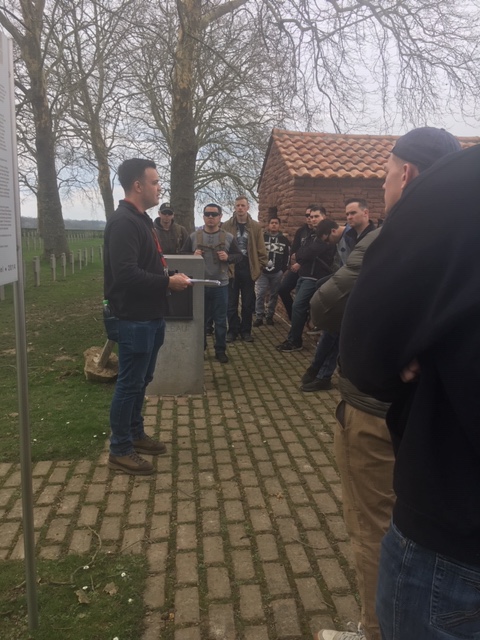 We paused there as Capt Steiger took the opportunity to inform us of the history that lead up to the events that would start WWI. We found it ironic that the leaders of Russia, Austria, Hungary and Germany were all cousins who simply could not get along. The continuous tensions that had been escalating for years came to a boiling point when Archduke Franz Ferdinand was killed. With the rest of the area seemingly rushing to declare their alliance with one side or another, it quickly escalated. Despite the German war strategy, which was designed to prevent the need to fight on two fronts, the entire region was quickly pulled into what is now known as World War One. The views from the German cemetery was just as sobering as from the American Cemetery. There lay thousands of sons, brothers, uncles and fathers, all of whom were fighting to serve their country.
We paused there as Capt Steiger took the opportunity to inform us of the history that lead up to the events that would start WWI. We found it ironic that the leaders of Russia, Austria, Hungary and Germany were all cousins who simply could not get along. The continuous tensions that had been escalating for years came to a boiling point when Archduke Franz Ferdinand was killed. With the rest of the area seemingly rushing to declare their alliance with one side or another, it quickly escalated. Despite the German war strategy, which was designed to prevent the need to fight on two fronts, the entire region was quickly pulled into what is now known as World War One. The views from the German cemetery was just as sobering as from the American Cemetery. There lay thousands of sons, brothers, uncles and fathers, all of whom were fighting to serve their country. 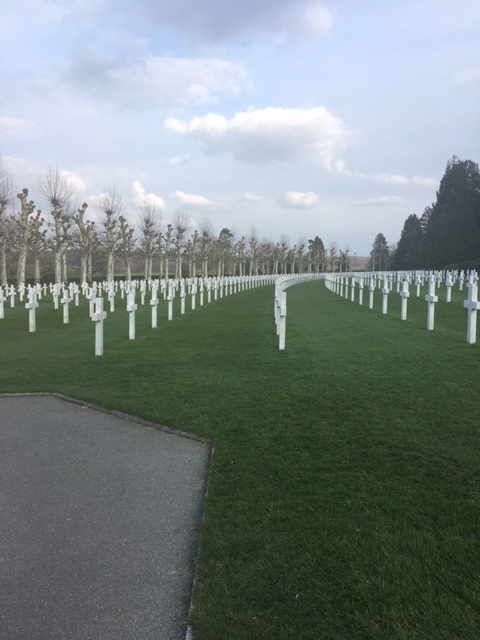 There was one area that was approximately 600 to 1000 square feet that simply put a chill down our spines. This was the area where over 4000 German soldiers were placed in a mass grave with no identification markers or way for their loved ones to pay their respect. It was as if their country had forgotten the sacrifice they made or simply did not care. Though we fought them in mortal combat the simple dignity and respect of caring for the dead was surprisingly lacking. It once again lead to a sense of pride as we remembered how we were trained to never leave a Marine behind. We believe this so strongly that even today we are still attempting to identify and recover the remains of fallen Marines from battles that raged some 100 years ago.
There was one area that was approximately 600 to 1000 square feet that simply put a chill down our spines. This was the area where over 4000 German soldiers were placed in a mass grave with no identification markers or way for their loved ones to pay their respect. It was as if their country had forgotten the sacrifice they made or simply did not care. Though we fought them in mortal combat the simple dignity and respect of caring for the dead was surprisingly lacking. It once again lead to a sense of pride as we remembered how we were trained to never leave a Marine behind. We believe this so strongly that even today we are still attempting to identify and recover the remains of fallen Marines from battles that raged some 100 years ago.
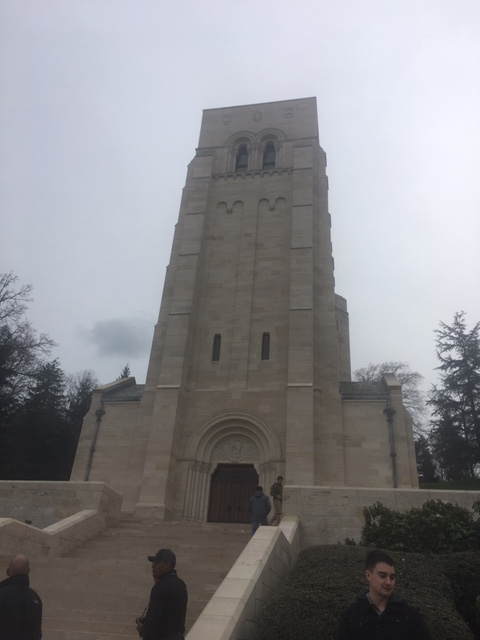 We proceed down the road toward the American cemetery. As we passed though the large iron gates we once again were blessed to see how beautiful and peaceful the area was. We continued to the Chapel which stood at the far end of the cemetery in the tree line which once was the source of a barrage of rifle fire, machine gun fire and artillery bombardment from the German forces which resulted in thousands of American deaths. Now this Holy Chapel stands watch over the thousands of graves that now rest in peace. Upon opening the large wooden doors we were amazed at the simple, majestic feel that swept over us as we lay our eyes on marble that ran from floor to ceiling. Each slab of marble was etched with the name of one of the fallen. An alter was present at the front of the chapel where visitors could pause and pray for those that lost their life as well as thank them for their selfless dedication to our Corps and Country.
We proceed down the road toward the American cemetery. As we passed though the large iron gates we once again were blessed to see how beautiful and peaceful the area was. We continued to the Chapel which stood at the far end of the cemetery in the tree line which once was the source of a barrage of rifle fire, machine gun fire and artillery bombardment from the German forces which resulted in thousands of American deaths. Now this Holy Chapel stands watch over the thousands of graves that now rest in peace. Upon opening the large wooden doors we were amazed at the simple, majestic feel that swept over us as we lay our eyes on marble that ran from floor to ceiling. Each slab of marble was etched with the name of one of the fallen. An alter was present at the front of the chapel where visitors could pause and pray for those that lost their life as well as thank them for their selfless dedication to our Corps and Country.

Upon exiting the Memorial Chapel we proceeded to the right and began climbing some old rough steps which lay in contrast to the large magnificent staircase which lead up to the chapel. These steps were covered in moss and displayed visible signs of wear from the vast number of people who have climbed them over the years. Upon completing the climb we found ourselves at the outskirts of the woods with a small path leading deeper in. We began down this path and noticed a small round stone building. Upon getting closer, it was easy to see all the battle scars it carried. Even now we could see that this building presented itself as the best all-around piece of cover. Capt Steiger stopped at the base of the building and informed us that the woods used to be a hunting preserve and that this former two story building was its hunting lodge. He also confirmed that both sides had used the building as an observation post at some point during the battle, not much unlike Schmucker Hall during the Battle of Gettysburg. He then took questions before leading us deeper into the infamous woods…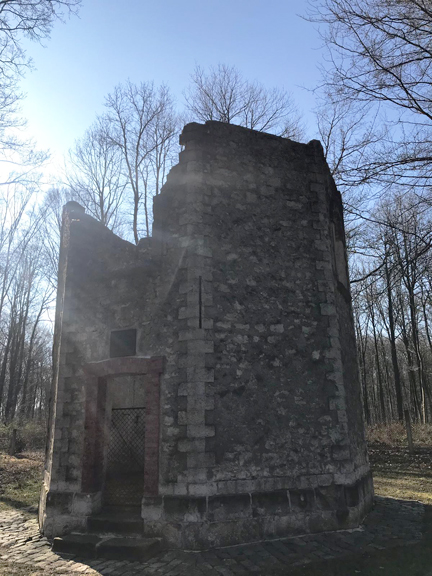 1st Trek Through the Woods
1st Trek Through the Woods
The foliage began to quickly thicken after passing the lodge. The path was still muddy even though the weather was beautiful. Marines and Sailors alike had the realization that they were standing in the place that forever established the legend of the Marine Corps. We started seeing remnants of the battle appearing. Old trenches, fighting holes, clearings where German artillery pieces used to sit and bullet holes peppering some of the older trees. Capt Steiger would occasionally turn around and give us bits of information, such as how the trenches were hastily made or how the German artillery teams ran. As we walked through the woods we were allowed to move at our own pace, giving us ample time to personally empathize with those that fought here over 100 years ago.
1st Stop on the Outskirts of the Woods – Hill 142
We eventually broke out of the woods, and as the trees and foliage disappeared, we arrived instantly into vast fields of farmland. Capt Steiger gathered us around and oriented us as to where we were. Hill 142 was visible to our right where Marines made their first assault on June 6th, 1917. The scene was painted for us. The waist high wheat fields, the unbearable heat, and the firepower and superior positioning of the German forces in the tree line. Several Marines remembered that while at the Marine Corps Museum in Quantico, VA. The short film shown about this battle did not do justice to the view of the battle field in real life. The utter carnage from those charges into heavy fire establishing the reputation of tenacity for which the Marines are well known. Capt Steiger went on to explain how the Germans had attacked the Marine line three days before; utilizing their bayonets, the Marines had dug shallow fighting holes in order to fight from the prone position. They then waited until the Germans were within 100 yards are so before devastating them with their 1903 bolt actions. During those first few days retreating French forces kept advising the Marines to retreat to which those famous words were uttered “Retreat? Hell we just got here!” Everyone in the group was looking around at the positions in the rocks. One Marine pointing out how devastating a single machine gun placed in the right spot could kill hundreds. We then proceeded back into the woods and continued along the trail.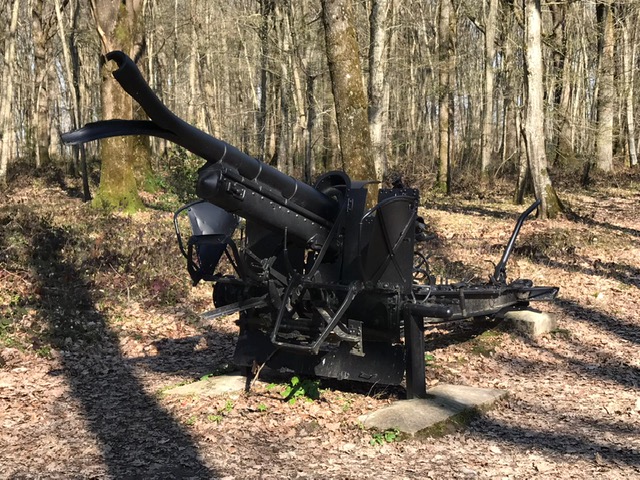 2nd Stop – South Fields Towards Paris
2nd Stop – South Fields Towards Paris
Winding through the woods again it was hard not to imagine what it must have been like during the battle. To see a German poking out from one of the trees, Mauser aimed. One of our Marine’s makes knives as a hobby and located a fallen branch that he took in order to make a handle out of it. We eventually emerged by a road where we halted again to hear about the next few days of battle from the Captain. The night of June 6th held more in store for the Marines. On the West side of the woods First Sergeant Dan Daly was motivating some machine gunners with another famous quote “Come on, you sons of bitches, do you want to live forever?” The attack was costly to say the least. Everyone was shocked to hear that the casualties sustained by the Marines in this one attack were higher than all the past battles of the Marines combined. But it was that attack that gave the Marines a foothold in Belleau Wood. One thing that the Captain kept mentioning was how important information could be. If things had played out just a little differently, things may have ended very differently. At one point the Marines were told to advance in the wrong direction, and were slaughtered by interlocking fields of machine gun fire. In this case the Marines tenacity came out and they ended up destroying the German’s southern defensive lines. It was then that a German private had written “We have Americans opposite us who are terribly reckless fellows.” 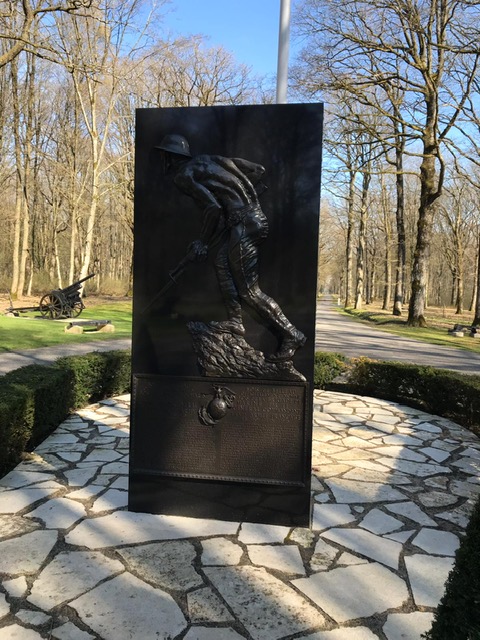 3rd Stop – Marine Monument and Artillery Pieces
3rd Stop – Marine Monument and Artillery Pieces
We could all see where we were headed next. Directly down the road was a black monolith surrounded by different artillery pieces. The walk didn’t take long to reach it. Everyone crowded around the monument which had a Marine, rifle in hand and bayonet fixed, made of molded metal on the face. Everyone spread out and investigated the decommissioned artillery pieces that surrounded the clearing. All kinds from all sides were there, some even bearing marks of war. There was one German artillery piece in particular that had shrapnel holes punching directly through the shield meant to protect the cannoneers. Marines took turns reading the plaque at the bottom of the monument, which gave a brief overview of the actions of the Marines in the battle and thanked those that sacrificed so much for their gallantry. We then proceeded towards our final stop of the tour.
Final Stop – 2nd Division Marker
We followed one of the roads down and around the outskirts of the wood. The vast wheat fields visible through the thinning line of trees. As we continued down the road there was a large formation of rocks, all with bullet holes still visible in their faces. Reaching the bottom of the hill we came upon two signs. On the left side of the road it said “Belleau Wood” and on the right it read “Bois de la Brigade de Marine.” Here Capt Steiger told of the final days of the battle, and in turn, the Great War as a whole. From June 10th to June 26th the Marines and the Army were the only ones on the offensive. On the final day of the battle the Marines cleared out the last remaining Germans in the woods, reporting back to higher “Woods now U.S. Marine Corps entirely.” The war ended not long after that and the Treaty of Versailles was signed, setting in motion a series of events that led to World War II 20 years later. Without the Marines, Paris may have fallen. The sacrifice of the men in those woods changed the course of history. The nickname of Teufel Hunden had been bestowed and the reputation of the U.S. Marines as the premier fighting force now circles the Globe. We realize that this reputation was paid for with the blood of those that came before us. We stand ready and willing to follow in their footsteps to defend and add to the incredible legacy that helped create. 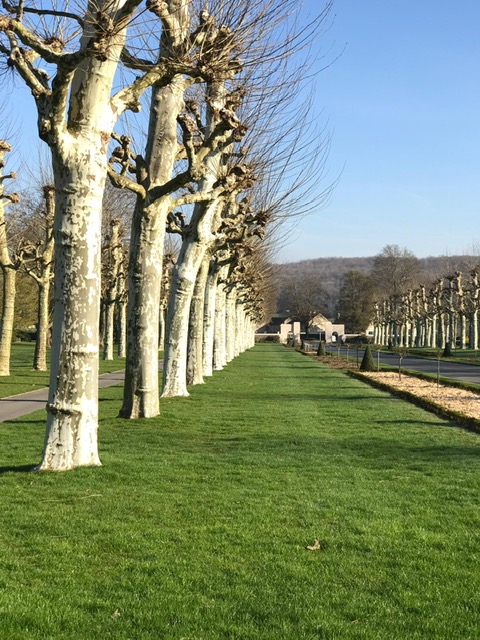 As you can see, the Marines conducting this battlefield study not only learned about a part of our illustrious history, they also learned about how important tactics, command and control, and combined arms are to any battle. For many of the Marines, this was their first time on a deployment outside the U.S. and being able to walk on such sacred ground so far from home humbled them. It also motivated them to learn from the battles of our past while paying attention to the changes in the future to ensure we remain ready to take the fight to America’s enemies in any climb or place. Again, thank you for your donation! We will never forget this experience.
As you can see, the Marines conducting this battlefield study not only learned about a part of our illustrious history, they also learned about how important tactics, command and control, and combined arms are to any battle. For many of the Marines, this was their first time on a deployment outside the U.S. and being able to walk on such sacred ground so far from home humbled them. It also motivated them to learn from the battles of our past while paying attention to the changes in the future to ensure we remain ready to take the fight to America’s enemies in any climb or place. Again, thank you for your donation! We will never forget this experience.
The Marine Corps University Foundation helps fund Marine PME like the one above for GDP RSM Georgia Training Team, ROTO 9 to Belleau Wood. We are a 501(c)(3) nonprofit organization, is the only Marine Corps charity solely dedicated to supporting the Professional Military Education (PME) of Active Duty and Reserve Officer and Enlisted Marines at the Marine Corps University and throughout the Operating Forces. The Marine Corps University leadership’s vision has been twofold – to prepare Marines at all levels to address complex security challenges in a rapidly transforming world through an unparalleled education in security and warfighting studies, and to groom the next generation of decision makers within the Marine Corps, government, and the private sector, equipping them with the critical thinking skills that will enable them to achieve success in any number of career paths. We rely on your tax-exempt contributions and from those who support Marine Corps causes, including Corporate Members, Marine friends, former Marines helping Marines and donations in memory or in honor of someone special to fund Marine PME like the one above. We are grateful for your tax-deductible donation to support the Professional Military Education of active duty and reserve Marines. Semper Fi!
Support Our Nation’s Greatest Asset
Every donation, no matter the size, has a significant impact on our nation’s greatest asset: OUR UNITED STATES MARINE CORPS


